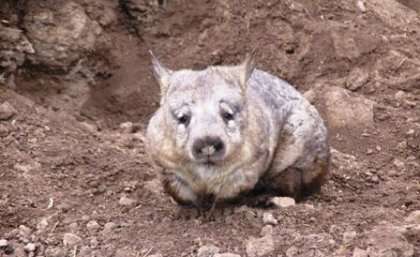Noninvasive solution to wombat conservation

Australia's critically endangered northern hairy-nosed wombats might not know it yet, but researchers from The University of Queensland are working on a wee solution to their population problems.
PhD student in UQ's School of Agriculture and Food Science (SAFS) Alyce Swinbourne is tickling the rumps of sleepy female southern hairy-nosed wombats as a prelude to collecting their wombat wee into a tiny frypan.
"People need to go when they wake up, and so do wombats," Alyce said.
"This study uses knowledge of wombats' natural behaviour to collect urine samples in a non-invasive way with little stress to them. I simply pull out the frypan by the handle when they're finished."
Alyce's classical conditioning methods have enabled her to collect close to 2500 urine samples —an approach believed to have never before attempted in a marsupial.
The research has a serious purpose. Wombats have proved a notoriously difficult species for which to develop assisted breeding techniques (artificial insemination) in captive management.
While she is working with the southern species, found widely in southern Australia, she hopes the work ultimately will assist in developing breeding programs to conserve their northern cousins—among the rarest land animals in the world.
There are only 200 known northern hairy-nosed wombats in the wild, most at Epping Forest National Park near Clermont, Central Queensland. Floods in 2001 led to the translocation of a smaller "insurance" population in case of further natural disasters at the first site.
"If we want to ensure their future, we need to develop assisted reproductive technologies to help in their recovery in reserve areas in the wild and this is where the scientific development of breeding programs comes in, based on better understanding of the animals' biology," she said.
Alyce has worked with wombats over two breeding seasons at Safe Haven - AACE (Australian Animals Care and Education) sanctuary for Australian wildlife in Mt Larcom, Central Queensland.
Associate Professor Steve Johnston and Dr Tamara Keeley of UQ's SAFS are supervising her research, and samples are being analysed at the Wildlife Endocrinology Laboratory at UQ's Gatton campus.
Alyce is working with Dr Keeley and Associate Professor Johnston to develop new diagnostic techniques to analyse reproductive hormones.
She is also observing wombat behaviour using infrared cameras, for six hours a day, for up to nine months, to gain a better understanding of the breeding behaviour.
Professor Clive Phillips, Director of UQ's Centre for Welfare and Ethics is also providing expert advice.
"I hope that the skills developed in this project will be transferable to other Australian marsupial species, such as koalas and gliders," Alyce said.
Now living in Adelaide where her husband, Mike, is also undertaking a PhD, Alyce said she had had "a ball" during her studies, although it was financially quite challenging. During her studies she has been a finalist in UQ's Three Minute Thesis competition, attended a Reproduction conference in South Australia, a wildlife conference in Hobart and was awarded a SAFS Travel Scholarship to present her findings in Germany in August, 2016.
Provided by University of Queensland


















